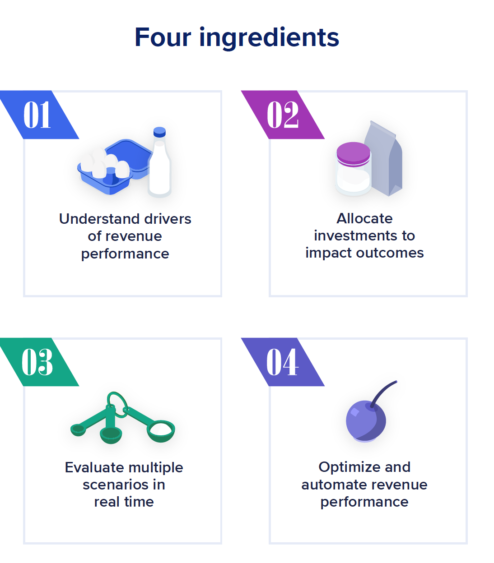Anaplan for Commercial Revenue Planning eases omnichannel planning shambles


A new all-in-one solution addresses the consumer goods industry’s multi-channel revenue planning challenges across multiple lines of business.
Manufacturers of consumer products are looking forward eagerly to the summer of 2021. They anticipate that as the threat of the pandemic fades, people will be planning more get-togethers and outings – all prefaced by shopping for snacks, sunblock, and maybe a cute pair of flip-flops or water-resistant smartwatch.
To compete successfully for consumers’ attention and dollars, manufacturers have to navigate a complex and fast-changing business process: planning the sales and consumer demand strategies that will first get their products into multiple consumer channels including stores, restaurants, concessions stands, vendor carts, kiosks, and online storefronts and then into the hands of buyers. And they need enough sales volume, profit margin, and predictability to ensure revenue streams that live up to quarterly and yearly targets.
Getting the right mix of products into the proper channels is only the tip of the iceberg. The more significant challenge is how to meet those revenue targets by investing in the appropriate pricing and promotional incentive programs, a balancing act known as “commercial revenue planning.”
The yards of coupons printed on your drugstore receipt are one of the ways that fast-moving consumer goods companies invest in consumer demand generation. Other activities include discounts or “buy one, get one free” offers, shelf signs in supermarkets, or even high-touch campaigns like contests, samples, and product placement. Additionally, manufacturers are constantly changing their prices in response to shifts in the market.
Multiply these fluctuations by dozens of brands, each with dozens or hundreds of individual product SKUs, across the thousands of venues where you could sell, and you can see how many moving parts the omnichannel sales process has.
Omnichannel complexity challenges manufacturers
Back at corporate headquarters, commercial planning leaders struggle to align their top-down sales targets for each brand and SKU with the bottom-up go-to-market plans and forecasts. Then they face the labor-intensive process of monitoring performance over time and adjusting plans to address variances from the forecasts and data gaps. Most of their planning process is driven by spreadsheets, so they don’t have the look-ahead capacity to build out and evaluate different scenarios. Therefore, they’re at risk of being overtaken by sudden shifts.
Meanwhile, they’re constantly having to coordinate their forecasts and activity plans with other functions, from manufacturing and logistics (because they don’t want to fall short of product just as ad campaigns are starting to boost demand) to finance, marketing, and sales. But this requires frequent hand-offs across departmental silos – often a breeding ground for errors, oversights, or delays.
Numbers tell the tale. According to our own research, the average fast-moving consumer goods (FMCG) company spends about 16% of its gross revenue on in-store promotions – and given how large many of these firms are, we could be looking at around $1.6 billion a year from a $10 billion company. Yet two-thirds of that promotional spending doesn’t hit its sales and profit goals. We’ve found that 83% of commercial planners don’t have the insight they need to plan in more detail than a high-level summary. And more than half of all companies have no cross-channel revenue planning strategy in place.
The great post-COVID economic reshuffle is making it painfully clear: The commercial revenue planning process is broken. And it’s holding back consumer product makers from taking advantage of the rebounding economy as much as they might.
We’ve seen in recent years how our customers adapt elements of our Connected Planning solutions to address the revenue planning mess. They find that Anaplan lets them seamlessly integrate annual planning processes across departments and lines of business; collaborate in real-time with trading partners, and shorten and streamline their annual planning processes to spend less time compiling data and validating assumptions and more time considering their options.
A recipe for growth
Inspired by these adaptations, we have created a new, all-in-one solution. Anaplan for Commercial Revenue Planning connects top-down and bottom-up planning of commercial targets across brands, regions, and channels. It combines elements of Anaplan’s solutions for budgeting, sales forecasting, new product introduction, trade promotion management, and marketing allocation into one convenient package that offers a recipe for accelerating topline revenue growth.
The Anaplan for Commercial Revenue Planning solution helps the product, sales, and finance experts level up their commercial planning operations with these four ingredients:
• Understanding drivers of revenue performance.
• Allocating investments to influence outcomes.
• Evaluating multiple scenarios in real-time.
• Optimizing and automating revenue performance.

The following is an example of how Anaplan uses those four ingredients to brings product, sales, and finance teams together to accelerate topline revenue growth.
Safe modeling and testing before you spend billions
Let’s say I’m a revenue planner at a major health and beauty products maker. I’m looking at a multi-billion-dollar annual budget to promote hundreds of products, from shampoo and deodorant down to shoe insoles. Typically, consumers buy those products in supermarkets and drugstore chains, our major trading partners. However, over the last year, we have experienced such a dramatic shift in consumer behavior that any sense of historical insight doesn’t apply. Now the recipe ingredients come into play:
1. Understand drivers of revenue performance. Gathering first-, second-, and third-party buying data sources with Anaplan would allow me to gain significant understanding of how market conditions may impact the kind of plan I’m used to running.
In addition to the $1.6 billion I can spend on in-store promotions (including discounts, coupons, and slotting fees), I have another $1.4 billion to spend on marketing campaigns across all other channels (with a minor share going to online sales). But now I notice the number of consumers buying online (including from our retail partners, third parties such as Drugstore.com or Amazon sellers, and directly from us) has been growing dramatically. In the latest quarter, online channels make up 10% of our business.
2. Allocate investments to influence outcomes. Now I need to reallocate my marketing spending among all those channels, to maximize our sales and not go broke by offering overly generous discounts or store incentives. With such massive operations, I’m not about to rely on guesswork or rigid formulas.
3. Evaluate scenarios in real time. With the Anaplan solution, I can simulate different scenarios – from the most conservative to the most radical shifts – in a sandbox environment and see how they pencil out. That way, I can figure out what promotional allocation plan will be the best fit for new product entries, channel switching, and other market conditions before pressing the button to make it happen (and spend $3 billion). If conditions change midway through the year – and we certainly know now how suddenly they can change – I can give other models test runs to see how they fit.
4. Optimize and automate revenue performance. Because the promotional cycle repeats every year, I would like to capture all the insights we have gained over the years and make my efforts smarter. Anaplan for Commercial Revenue Planning is AI-enriched, so it can predictively forecast outcomes based on historical and other data, then recommend the best promotional scenario.
Helping the top and bottom lines
This new solution helps companies realize more profits in several ways:
• Productivity gains: An estimated 50% less time is required to gather and consolidate data for annual reporting and forecasting. (We estimate this could save a large company $300–400,000 a year in worker time, as well as let it react more nimbly to change.)
• Spend optimization: More effectively targeted trade promotion spending, cutting wasted spending by 1-2%. (Saving around $16-30 million a year, for a company spending $1.6 billion on promotions.)
• Revenue growth: As much as 1% added to topline revenue due to scenario-based planning, bringing in an extra $100 million a year for a company with estimated revenues of $10 billion a year.
With this kind of growth in profitability, commercial revenue planners might be able to take real vacations this summer.
Over the next several weeks, we’ll explore in more depth the Anaplan for Commercial Revenue Planning recipe for boosting profit. We’ll look at drivers of revenue performance, better allocating investments to influence outcomes, using the patented Anaplan Hyperblock technology to evaluate multiple scenarios in real-time, and optimizing and automating revenue performance.